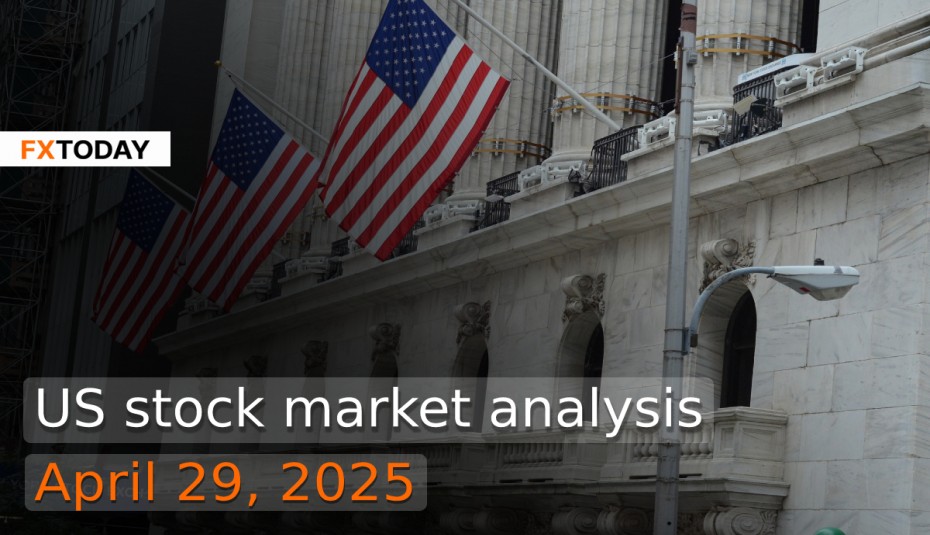Wall Street Eyes Earnings, Data as US30 Tests Key Levels
U.S. stocks ended higher last Friday, wrapping up a strong week fueled by renewed optimism in tech shares and continued monitoring of global trade tensions. Despite the rally, the S&P 500 remains down 1.5% for April, and the Dow is lower by 4.5%, whereas the Nasdaq has turned slightly positive for the month. Trading on Monday reflected a cautious mood, with the Dow and S&P 500 ending slightly higher and the Nasdaq fractionally lower. Weakness in mega-cap tech names like Nvidia and Amazon weighed on the Nasdaq and the S&P 500, although modest gains in Apple and Meta provided some offset. The S&P 500’s slight advance marked its fifth straight day of gains—the longest streak since early November—though overall market action remained choppy without a major catalyst.
Investors are sharply focused on this week, which is critical for market sentiment given the heavy slate of corporate earnings and key economic data releases. Tech giants including Apple, Microsoft, Amazon, and Meta Platforms—all part of the "Magnificent Seven"—are scheduled to report earnings. These companies have struggled to maintain their previous momentum in 2025 after posting massive gains in prior years. Nvidia shares fell more than 2% last week amid reports that China’s Huawei is developing AI chips to compete with Nvidia’s high-end offerings, adding to pressure on the broader tech sector. Nevertheless, Alphabet emerged as a bright spot, gaining 1.7% on Friday following strong cloud revenue and notable progress in AI investments, while Tesla and Apple posted slight gains that helped cushion broader tech sector weakness.
Outside of tech, Boeing shares rose 2.4% after Bernstein upgraded its stock rating and target price, keeping the Dow in positive territory despite broader concerns. Spirit AeroSystems also advanced 2.6% after Airbus finalized a deal to acquire some of its operations, receiving compensation to help Spirit complete its acquisition by Boeing.
Meanwhile, trade tensions between the U.S. and China remained unresolved, with Beijing partially easing tariffs on U.S. goods but denying President Trump’s claims that negotiations had resumed. U.S. Treasury Secretary Scott Bessent indicated that many countries had made promising tariff proposals but emphasized that it was up to China to de-escalate further. Despite these minor positive signs, overall market sentiment remains fragile, and a Reuters poll showed that economists now see a high risk of a global recession due to the ongoing tariff battles.
Adding to the week’s complexity, major economic releases—including the first estimate of Q1 GDP, PCE inflation data, manufacturing activity, and the monthly jobs report—could significantly influence the market outlook and monetary policy expectations. First-quarter earnings so far have been stronger than expected, tracking a 9.7% year-over-year rise, exceeding earlier forecasts. However, companies have expressed growing uncertainty around future profits due to trade policy risks, with negative earnings outlooks outnumbering positive ones among S&P 500 firms by roughly a 2.4-to-1 ratio.
Several high-profile analyst actions reflected these uncertainties. Bank of America cut its price target on Apple to $240 from $250 due to delays in launching an AI-enabled Siri and rising supply chain costs tied to tariff concerns. Although BofA maintained a Buy rating, it warned that delays could dampen iPhone upgrade demand, cutting fiscal 2026 EPS estimates from $8.20 to $7.82 and revenue projections from $450 billion to $440 billion. However, upcoming product launches, including a thinner iPhone Air in 2025 and a foldable model in 2026, as well as tailwinds from a weaker dollar, could help mitigate some of the pressure.
Raymond James downgraded Amazon to Outperform from Strong Buy, slashing its price target to $195 from $275, citing underestimated EBIT margin pressures, rising logistics costs after UPS’s exit, and Amazon’s exposure to China, which could hurt profitability under new tariffs. While Amazon’s AI potential remains strong, monetization efforts are still developing and investment-heavy, prompting Raymond James to favor Meta, Uber, and MercadoLibre over Amazon due to their clearer AI monetization paths.
D.A. Davidson downgraded Salesforce to Underperform from Neutral and cut its price target to $200 from $250, criticizing the company’s pivot toward AI initiatives at the expense of its core SaaS business. The brokerage flagged slowing growth across legacy segments like Slack and Tableau and expressed concerns that much of Salesforce’s reported $900 million AI run-rate stems from bundled pricing rather than organic demand. Davidson forecasts fiscal 2026 revenue growth slowing to 5.5%, below the 7.5% consensus, and warns of further deceleration outside of AI.
On the broader macro front, JPMorgan’s analysts remain cautious in the near term, citing softening economic data, elevated tariff concerns, and weak earnings revisions. Although they anticipate a better setup for equities in the second half of 2025, they believe international markets currently offer better risk-reward opportunities than the U.S.
The upcoming week will be crucial, with earnings from tech giants Apple, Amazon, Microsoft, and Meta offering critical insights into corporate resilience amid escalating tariff pressures. Markets are also bracing for key economic data releases, including U.S. GDP, PCE inflation, manufacturing activity, and April’s jobs report. Against the backdrop of unresolved U.S.-China trade tensions, attention will also be on Warren Buffett’s Berkshire Hathaway annual meeting, where investors will watch closely for insights into how the firm plans to deploy its $334 billion cash pile.
As a result, the US30 index faces a critical juncture this week as investors weigh a mix of strong earnings momentum against persistent macroeconomic headwinds. Should earnings results and economic indicators surpass expectations, the Dow may attempt a move toward the 40,800–41,000 zone. However, disappointing data or further trade friction could trigger renewed selling pressure, risking a pullback toward the 39,500–39,700 support area. Overall, short-term price action is likely to remain choppy, with a slight bearish tilt unless a clear positive catalyst emerges.
Data for Technical Analysis (1H) CFD US30 DJIA
Resistance : 40307.3, 40321.6, 40344.7
Support : 40261.1, 40246.8, 40223.7
1H Outlook
Source: TradingView
Buy/Long 1 If the support at the price range 40181.1 - 40261.1 is touched, but the support at 40261.1 cannot be broken, the TP may be set around 40323.4 and the SL around 40141.1, or up to the risk appetite.
Buy/Long 2 If the resistance can be broken at the price range of 40307.3 - 40387.3, TP may be set around 40410.0 and SL around 40221.1, or up to the risk appetite.
Sell/Short 1 If the resistance at the price range 40307.3 - 40387.3 is touched, but the resistance at 40307.3 cannot be broken, the TP may be set around 40261.1 and the SL around 40427.3, or up to the risk appetite.
Sell/Short 2 If the support can be broken at the price range of 40181.1 - 40261.1, TP may be set around 40167.0 and SL around 40347.3, or up to the risk appetite.
Pivot Points Apr 29, 2025 02:39AM GMT
|
Name
|
S3
|
S2
|
S1
|
Pivot Points
|
R1
|
R2
|
R3
|
|---|---|---|---|---|---|---|---|
| Classic | 40202.4 | 40223.7 | 40262.9 | 40284.2 | 40323.4 | 40344.7 | 40383.9 |
| Fibonacci | 40223.7 | 40246.8 | 40261.1 | 40284.2 | 40307.3 | 40321.6 | 40344.7 |
| Camarilla | 40285.4 | 40290.9 | 40296.5 | 40284.2 | 40307.5 | 40313.1 | 40318.6 |
| Woodie's | 40211.2 | 40228.1 | 40271.7 | 40288.6 | 40332.2 | 40349.1 | 40392.7 |
| DeMark's | - | - | 40273.5 | 40289.5 | 40334 | - | - |
Sources: Investing 1, Investing 2
















